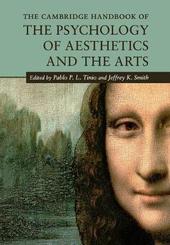
|
The Cambridge Handbook of the Psychology of Aesthetics and the Arts
Paperback / softback
Main Details
| Title |
The Cambridge Handbook of the Psychology of Aesthetics and the Arts
|
| Authors and Contributors |
Edited by Pablo P. L. Tinio
|
|
Edited by Jeffrey K. Smith
|
| Series | Cambridge Handbooks in Psychology |
|---|
| Physical Properties |
| Format:Paperback / softback | | Pages:646 | | Dimensions(mm): Height 245,Width 170 |
|
| Category/Genre | The arts - general issues
Theory of art
Philosophy - aesthetics |
|---|
| ISBN/Barcode |
9781108402675
|
| Classifications | Dewey:111.85019 |
|---|
| Audience | | Professional & Vocational | |
|---|
| Illustrations |
6 Tables, black and white; 35 Halftones, unspecified; 35 Halftones, black and white; 6 Line drawings, black and white
|
|
Publishing Details |
| Publisher |
Cambridge University Press
|
| Imprint |
Cambridge University Press
|
| Publication Date |
6 April 2017 |
| Publication Country |
United Kingdom
|
Description
The psychology of aesthetics and the arts is dedicated to the study of our experiences of the visual arts, music, literature, film, performances, architecture and design; our experiences of beauty and ugliness; our preferences and dislikes; and our everyday perceptions of things in our world. The Cambridge Handbook of the Psychology of Aesthetics and the Arts is a foundational volume presenting an overview of the key concepts and theories of the discipline where readers can learn about the questions that are being asked and become acquainted with the perspectives and methodologies used to address them. The psychology of aesthetics and the arts is one of the oldest areas of psychology but it is also one of the fastest growing and most exciting areas. This is a comprehensive and authoritative handbook featuring essays from some of the most respected scholars in the field.
Author Biography
Pablo P. L. Tinio is Associate Professor at Montclair State University, New Jersey. Jeffrey K. Smith is Professor and Associate Dean for Research in the College of Education at the University of Otago, New Zealand.
Reviews'This book is a significant contribution to furthering our understanding about the importance and value of aesthetics within different art forms and contexts. It has cross-disciplinary appeal and helps to promote both theoretical development and applied research, while opening the study of aesthetics to a broader audience.' Paul M. Camic, Salomons Centre for Applied Psychology, Canterbury Christ Church University, Kent 'This volume is impressive in both its breadth and depth. I work in this area, yet I learned something from each and every chapter about the psychology of aesthetics and art, and - perhaps more importantly - how aesthetics and art contribute to the human condition. This book will be kept on my desk so I can have easy access to it!' Jonathan Plucker, Raymond Neag Professor of Education, University of Connecticut 'This volume brings together important scholarship and groundbreaking methodological approaches for understanding the fundamental question of how and why art moves us. Although an individual's experience of art is inherently subjective, these collected essays draw on research in psychology and aesthetics to bring new insights to a topic that historically many scholars in the field had considered too indefinable to analyze or quantify.' Kathryn Potts, Helena Rubinstein Chair of Education, Whitney Museum of American Art
|